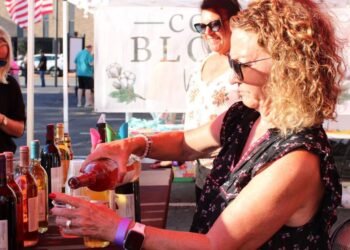(THE CONVERSATION) Every year, five hours west of Mexico City on Lake Pátzcuaro in Michoacán, residents flock to the island of Janitzio to visit the graves of their departed relatives.
On the evening of Nov. 1, the Noche de animas, or Night of the Souls in Purgatory, families will bring a meal to share with their ancestors. They will also use the time to clean the graves and decorate them with elaborate displays of candles and marigolds. Some will spend the night sleeping among the tombstones.
In Mexico City, parades will feature people in colorful customs with large skull masks while skull-shaped floats move through the streets to the rhythm of Aztec drums. Marigolds, skull-painted faces and swishing skirts will fill the downtown from the main square of the Zócalo to Bellas Artes, the Palace of Fine Arts.
This vibrant scene reflects the blending of Indigenous, European and specifically Mexican customs that define Day of the Dead celebrations today.
As a scholar of colonial Mexico, I study how Indigenous people have maintained their traditions despite the Spanish invasion. Whereas scholars once thought that these cultures simply blended – a phenomenon called syncretism – researchers today understand more about how Indigenous people intentionally deliberated about which of their own traditions to continue, and how.
Celebrations for the dead had an important place in Indigenous cultures before the Spanish came. But, as historian James Lockhart explained, the Spanish, in their attempts to impose their religion and customs, often did not recognize what was most important to local cultures. As long as Indigenous celebrations for the dead did not contradict Spanish preaching, they could go unnoticed.
Indigenous choices
The immediate effects of the Spanish invasion brought hard choices for Indigenous people. Most of the Indigenous deaths of the conquest came not by the sword, but by epidemic diseases such as smallpox and salmonella, for which the native population had no natural immunity. In the 16th century, whole towns depopulated, and people needed to decide where they would go to find the best opportunities.
After the Spanish came, around Lake Pátzcuaro, displaced families suffering the effects of European illnesses and the deaths of family members moved to cities and towns. On the shores of the lake and on the island of Janitzio, they continued their customs of sharing harvest produce with the dead.
Setting aside time to care for the tombs of the dead became a yearly observance during the colonial period. After independence from Spain in 1821, a series of state decrees in Michoacán even encouraged residents to honor the war heroes buried on Janitzio.
Since the island had already been sacred for hundreds of years, it was a logical site for the veneration of the new heroes of Mexican independence. So, patriotism strengthened the Indigenous tradition of honoring the dead, which was already underway.
How Indigenous practices survived
In Mexico City, colonial policies also ironically allowed Indigenous practices to survive. Before the Spanish came, the Aztecs displayed thousands of skulls of sacrificial victims on a skull rack, called the tzompantli.
In their view, the vital energy released from sacrificed bodies fed the Sun and ensured that the universe continued.
The Aztecs honored many of their sacrificial victims before these rituals with days of feasting, fine clothes, luxury lodging and other pleasures. Each year, during the festival of Miccailhuitontli, the “little feast of the dead” in the ninth month of the Aztec calendar, children were ritually killed. In the tenth month, it was the adults who were sacrificed during the festival of Huey Miccailhuitl, “great feast of the dead.”
Although Spanish military invaders suppressed these celebrations, they also unintentionally gave the newly colonized Aztecs ways to combine their beliefs with Christian celebrations.
Franciscans and other religious orders who followed brought the medieval rituals of religious theater and processions as part of their efforts to convert the local people. Both of these highly public medieval practices gathered large numbers of spectators, as Aztec rituals had done before the invasion.
The Indigenous actors in these plays, themselves recent converts, portrayed pageants during Christmas, Holy Week and other observances.
While the friars did not plan to draw on Indigenous beliefs, these religious plays had parallels with the preconquest Aztec practice of deity impersonation. For example, before the Spanish came, in the festival of Toxcatl the Aztecs would dress up a specially chosen prisoner as their deity of divination Tezcatlipoca. The impersonator danced and paraded through the city on his way to be sacrificed atop the main temple.
When Catholic religious theater came to the city, local actors continued to take on the persona they represented to such a degree that one local actor even hanged himself after portraying Judas in a Passion play.
During the long colonial period, from the 16th to the 18th century, religious processions became a mainstay in the city. Historian Susan Schroeder recounts the chronicles of the Indigenous writer Domingo Chimalpahin about multiple processions as a source of Indigenous communities’ civic pride.
Over time, taking cues from the “mascaradas” – the large, papier-mâché heads of Spanish processions and festivals – Day of the Dead began featuring enormous, colorful skulls parading through the streets, just feet away from where the Aztecs once displayed human skulls.
Beyond graves
Besides the usually cited All Saints’ Day and All Souls’ Day on Nov. 1 and 2, more covert European elements have influenced Day of the Dead practices. One of these is the belief in the soul and an afterlife. Historian Jill McKeever Furst explains that in the Aztec view, only death in battle or during childbirth earned immortality.
Most people went to Mictlan, the Land of the Dead, releasing their vital energy into the universe and ceasing to exist as individuals. Today, depictions of the living interacting with the dead, singing to or talking with them, such as in the movie “Coco,” likely reflect adapted ideas about the afterlife from Christianity, as cultural critic Anise Strong has noted.
European influences have also shaped home altars with their seven or nine levels, representing layers of underworld, Earth and paradise. Research has revealed that many Indigenous communities in what is now Mexico viewed the universe as flat and placed Mictlan far away from the living, rather than below the Earth.
Historians Jesper Nielsen and Toke Reunert have noted that it is likely that Indigenous images of the universe as made of three realms, with a reward in the sky, Earth in the middle, and the world of the dead below, come from Dante’s “Divine Comedy”. Dante’s literature depicts the universe in a vertical fashion – from the heights of heaven, through purgatory, Earth and with abysmal hell at the bottom.
As local people converted, they left horizontal views of the universe and moved toward a positive up and a negative down. The vertical cosmos contrasts with ancestral Indigenous views of the universe as a plane where humans and supernatural beings interacted.
Celebrations continue
The island of Janitzio on Lake Pátzcuaro and Mexico City show how Indigenous choices helped their traditions survive despite Spanish influence. In the city of Pátzcuaro, sharing food with the dead during harvests continued alongside All Saints’ Day and All Souls’ Day. Meanwhile, in Mexico City, the history of public ritual sacrifice gave way to the religious pageantry of Spain’s Renaissance.
Today, individuals and groups continue to decide how to celebrate the Day of the Dead. Whether it’s about communicating with the dead, letting go, or believing they remain among the living, the holiday’s strength lies in its ability to hold many meanings.
As long as Indigenous, Spanish and modern Mexican customs continue in home rituals and public celebrations of past lives, current lives and cultural heritage, the Day of the Dead will be alive and well.
Want to reach a local audience and grow your business?
Our website is the perfect platform to connect with engaged readers in your local area.
Whether you're looking for banner ads, sponsored content, or custom promotions, we can tailor a package to meet your needs.
Contact us today to learn more about advertising opportunities!
CONTACT US NOW




